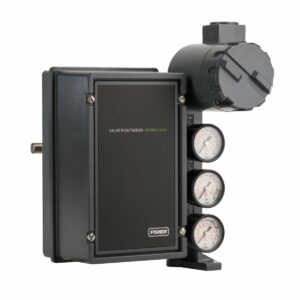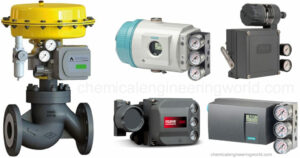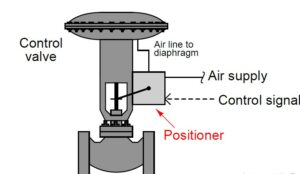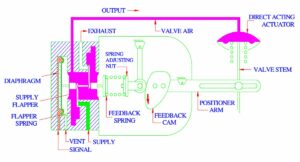Valve Positioner is one of the most extensively used control valve accessories in different industries.
To regulate the rate of gas and liquid flow, a large number of valves are used in oil and chemical plants as well as food, pharmaceutical, steel plants. Each valve is associated with a positioner that controls the valve’s position according to the command from the control system.
What is a Valve Positioner?
Valve Positioner is a device installed with a control valve to get precise and rapid control over flow, to reduce frictional effect and steady valve position even with fluctuating pressure.

Valve Positioner, Image Source: cascadeautomation
The use of a Valve Positioner with a control valve is essential to get accurate and quick control without any hysteresis. The controller sends a direct input signal to the Positioner instead of the actuator. The control signal applied to the Positioner operates the actuator stem through a flapper nozzle mechanism.

Valve Positioner, Image Source: chemicalengineeringworld
Valves are a vital part of any industry that is installed on pipes to control the flow rate of gases and liquids. Hundreds and thousands of valves are required as per the capacity of a plant. Proper control of opening and closing and adjustment of degree of opening of these valves is essential. To get the correct stem or shaft position as set by the control system, Valve Positioners are used widely so that depending on the input from the controller, it can adjust the air pressure to the actuator diaphragm to maintain the correct stem position of the valve.
Where is a Valve Positioner located?
Valve positioners are installed with a control valve to regulate the position of a valve depending on the predecided data for a process variable which may be flow, pressure, or temperature.
As per the type of Valve actuator, the position of Valve Positioner is determined. Normally, the location of a Positioner in case of pneumatic type actuator for a linear control valve is yolk or top casing. In a rotary control valve, the Positioner is located close to the end of the shaft.
Whether rotary or linear, in either types of control valve, the positioner sits and travels along with the valve stem. It measures the distance travel in case of linear valve and degree of rotation for rotary valves and controls the valve as per the points set by the controller.

Location Of a valve Positioner, Image Source: instrumentationtools
What is the necessity of a Valve Positioner?
Valve Positioner helps a control valve to respond quickly as per the changes of the process variable. They are advantageous for a system where fluctuations are the main obstacles to efficiency and quality.
The necessities of a Valve Positioner are explained below:
- Speed: Valve Positioner minimizes the response time of the system, whether operating above or below the set point
- Accuracy: A Positioner gives better resolution and more precision than an actuator can provide on its own. Controller send input signal directly to Valve Positioner. The feedback mechanism provided in the positioner allows to cross-check the valve position and readjust air requirement/pressure to reposition the stem as per the signal provided by the controller. Reduction in friction: Reduces friction effect of valve stem packing, especially beneficial for high-temperature packing material like graphite.
- Range: Valve Positioners also help to control a wide throttling range.
- Split Ranging: Using a Valve Positioner, we can use two valves with one controller(4-12 mA and 12-20mA) without any error.
- Seating friction: Help to defeat seating friction in case of a rotary valve.
- Increased flexibility: By using a Valve Positioner actuator is enable to face high apparatus air supply pressure.
- Flexible configuration: Utilization of a Positioner removes the limitation on distance between the controller and the control valve as the control signal can be sent electronically and converted to pneumatic signal at the input point of the Positioner. On the other hand if an actuator is operated pneumatically over long distance, the control becomes erratic.
Valve Positioner types
A Valve Positioner can receive or transmit both electrical as well as pneumatic signal. The classification of Valve Positioner is based on type of signal it can receive and transmit or a combination of both.
Different types of Valve Positioners are:
- Pneumatic Valve Positioner: This type of Positioner get pneumatic signal from controller and they also transmit pneumatic signal to the actuator. They provide a high air pressure to change the position of the actuator and are quite safe for use.
- Electric valve positioners: They transmit and accept electrical signals.
- Electro-pneumatic valve positioners: Also known as “Analog Positioner” because the electrical input received are in the form of analog signals. An electrical signal is fed from the controller but in return Positioner deliver a corresponding pneumatic signal to the pneumatic valve actuator.
- Digital or “smart” valve positioners: Popularly known as “Smart Valve Positioners.” This type of Positioner uses a microprocessor to control the valve actuator and record and monitor data. The electrical input is in the form of a digital signal, and the corresponding output is a pneumatic signal.
Valve Positioner working principle
A pneumatic Valve Positioner is a mechanical device employed to fine-tune the movement of the stem of a control valve.
The pneumatic Positioner is provided with a feedback mechanism to accurately identify the control valve stem position and compares it with the input signal. Based on the feedback signal, the positioner varies the supply of air to the actuator stem in order to bring the stem into the position dictated by the signal sent to the Positioner from the controller.
There are two philosophies on how a positioner is implemented. One is where the air is used to opena valve stem, and the other is when to air the used to close a valve stem. The description of the mechanism noted below is for the second case, i.e., the air is used for closing a valve stem. This is also called a direct-acting Valve Positioner.

Direct Acting Valve Positioner, Image Credit: instrumentationtools
The Positioner is normally fitted into the yolk or pillars of the actuator. It is operated by an input air pressure of 3-15 psi (0.2 bar to 1.1 bar); as the signal is provided from the controller to open the valve stem, the input air pressure to the input instrument increases. The input pressure acts on the input signal diaphragm, which drives the diaphragm along with the flapper connecting stem. The flapper connecting stem opens the supply flapper allowing the supply air to act on the actuator stem diaphragm.
During this time, the exhaust flapper is in the closed position as the flapper connecting stem is deflected to the right. As the air pressure is increased, it forces the valve stem down. As shown in the figure above, the positioner lever moves clockwise as the valve stem goes down.

Image Credit: instrumentationtools
Due to this clockwise rotation of positioner lever, range spring experiences a compression through cam. As soon as the valve stem reaches the position as per the set point provided by the controller the range spring exerts a balancing force closing both the exhaust and supply flapper and the desired control action is achieved.
On the other hand, if the controller sends a signal to open the valve, the signal pressure decreases. With the decrease in signal pressure, the force from the range spring push the flapper linking stem towards left direction. As a result, the exhaust flapper is opened. The force acting on the actuator diaphragm also decreases causing a upward movement of the valve stem until an equilibrium in force balance is achieved.

I am Sangeeta Das. I have completed my Masters in Mechanical Engineering with specialization in I.C Engine and Automobiles. I have around ten years of experience encompassing industry and academia. My area of interest includes I.C. Engines, Aerodynamics and Fluid Mechanics. You can reach me at